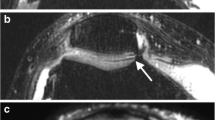Abstract
Purpose
To assess 3-T imaging of the knee.
Materials and methods
We reviewed 357 3-T magnetic resonance images of the knee obtained using a dedicated knee coil. From 58 patients who had arthroscopy we determined the sensitivity and specificity for anterior cruciate ligament (ACL) tear and medial and lateral meniscal tear.
Results
A chemical shift artifact showed prominently at 3 T even after improvements had been made by increasing the bandwidth. For complete ACL tear the sensitivity was 100% (95% confidence interval, CI, 75.30–100.00), and the specificity was 97.9% (95% CI 87.7–99.9). For the medial meniscus the sensitivity was 100.00% (95% CI 90.0–100.00), and the specificity was 83.3%(95% CI 66.6–95.3). For the lateral meniscus the sensitivity was 66.7% (95% CI 38.4–88.2), and the specificity was 97.6% (95% CI 87.1–99.9).
Conclusions
In general 3-T imaging allows a favorable display of anatomy and pathology. The lateral meniscus was assessed to be weaker than the other anatomic structures. Three-tesla imaging allows increased signal-to-noise ratio, increased resolution, and faster scanning times.














Similar content being viewed by others
References
Chan WP, Peterfy C, Fritz RC, Genant HK. MR diagnosis of complete tears of the anterior cruciate ligament of the knee: importance of anterior subluxation of the tibia. AJR Am J Roentgenol 1994; 162:355–360.
McCauley TR, Moses M, Kier R, Lynch JK, Barton JW, Jokl P. MR diagnosis of tears of anterior cruciate ligament of the knee: importance of ancillary findings. AJR Am J Roentgenol 1994; 162:115–119.
Murphy BJ, Smith RL, Uribe JW, Janecki CJ, Hechtman KS, Mangasarian RA. Bone signal abnormalities in the posterolateral tibia and lateral femoral condyle in complete tears of the anterior cruciate ligament: a specific sign? Radiology 1992; 182:221–224.
Tung GA, Davis LM, Wiggins ME, Fadale PD. Tears of the anterior cruciate ligament: primary and secondary signs at MR imaging. Radiology 1993; 188:661–667.
Vahey TN, Hunt JE, Shelbourne KD. Anterior translation of the tibia at MR imaging: a secondary sign of anterior cruciate ligament tear. Radiology 1993; 187:817–819.
Remer EM, Fitzgerald SW, Friedman H, Rogers LF, Hendrix RW. Anterior cruciate ligament injury: MR imaging diagnosis and patterns of injury. Radiographics 1992; 12:901–915.
Crues JV 3rd, Mink J, Levy TL, Lotysh M, Stoller DW. Meniscal tears of the knee: accuracy of MR imaging. Radiology 1987; 164:445–448.
De Smet AA, Graf BK. Meniscal tears missed on MR imaging: relationship to meniscal tear patterns and anterior cruciate ligament tears. AJR Am J Roentgenol 1994; 162:905–911.
Mink JH, Levy T, Crues JV 3rd. Tears of the anterior cruciate ligament and menisci of the knee: MR imaging evaluation. Radiology 1988; 167:769–774.
Boeree NR, Watkinson AF, Ackroyd CE, Johnson C. Magnetic resonance imaging of meniscal and cruciate injuries of the knee. J Bone Joint Surg Br 1991; 73:452–457.
Mackenzie R, Palmer CR, Lomas DJ, Dixon AK. Magnetic resonance imaging of the knee: diagnostic performance studies. Clin Radiol 1996; 51:251–257.
Rubin DA, Paletta GA Jr. Current concepts and controversies in meniscal imaging. Magn Reson Imaging Clin North Am 2000; 8:243–270.
Escobedo EM, Hunter JC, Zink-Brody GC, Wilson AJ, Harrison SD, Fisher DJ. Usefulness of turbo spin-echo MR imaging in the evaluation of meniscal tears: comparison with a conventional spin-echo sequence. AJR Am J Roentgenol 1996; 167:1223–1227.
Cheung LP, Li KC, Hollett MD, Bergman AG, Herfkens RJ. Meniscal tears of the knee: accuracy of detection with fast spin-echo MR imaging and arthroscopic correlation in 293 patients. Radiology 1997; 203:508–512.
Rubin DA, Kneeland JB, Listerud J, Underberg-Davis SJ, Dalinka MK. MR diagnosis of meniscal tears of the knee: value of fast spin-echo vs. conventional spin-echo pulse sequences. AJR Am J Roentgenol 1994; 162:1131–1135.
Hendrick RE, Russ PD, Simon JH. MRI: principles and artifacts. New York: Raven; 1993: 191–192.
Mlynarik V, Degrassi A, Toffanin R, Vittur F, Cova M, Pozzi-Mucelli RS. Investigation of laminar appearance of articular cartilage by means of magnetic resonance microscopy. Magn Reson Imaging 1996; 14:435–442.
Xia Y, Farquhar T, Burton-Wurster N, Lust G. Origin of cartilage laminae in MRI. J Magn Reson Imaging 1997; 7:887–894.
Goodwin DW, Wadghiri YZ, Zhu H, Vinton CJ, Smith ED, Dunn JF. Macroscopic structure of articular cartilage of the tibial plateau: influence of a characteristic matrix architecture on MRI appearance. AJR Am J Roentgenol 2004; 182:311–318.
Author information
Authors and Affiliations
Corresponding author
Rights and permissions
About this article
Cite this article
Craig, J.G., Go, L., Blechinger, J. et al. Three-tesla imaging of the knee: initial experience. Skeletal Radiol 34, 453–461 (2005). https://doi.org/10.1007/s00256-005-0919-6
Received:
Revised:
Accepted:
Published:
Issue Date:
DOI: https://doi.org/10.1007/s00256-005-0919-6




